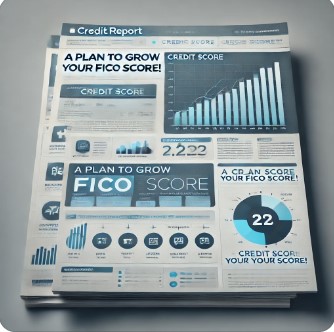You can’t build a solid financial future if your FICO score is holding you back. It’s great that people from all financial backgrounds are talking about improving their credit scores, but too few truly understand what it takes to enhance it. If you’re serious about your financial health, you can’t ignore your FICO score. Let’s dive into what it takes to boost that crucial number.
What Is a FICO Score and How to Improve It?
Ever wondered why lenders care so much about a three-digit number? Your FICO score isn’t just a random figure; it’s a snapshot of your creditworthiness that influences everything from loan approvals to interest rates. A higher score can save you thousands over the life of a mortgage or car loan.
Before you can grow your FICO score, you need to understand what it is and how it’s calculated. The FICO score ranges from 300 to 850 and is determined by five key factors:
- Payment History (35%): Consistently paying your bills on time is crucial.
- Amounts Owed (30%): This is your credit utilization ratio—the amount you owe compared to your credit limits.
- Length of Credit History (15%): The longer your credit accounts have been open, the better.
- Credit Mix (10%): A variety of credit types, like credit cards and loans, can positively impact your score.
- New Credit (10%): Frequent applications for new credit can lower your score.
Improving your FICO score isn’t just about focusing on one aspect; it’s about managing all these factors effectively.
Step-by-Step Plan to Boost Your Score
- Check Your Credit Reports Regularly
Start by obtaining free copies of your credit reports from the three major bureaus: Experian, TransUnion, and Equifax. Review them meticulously for errors like incorrect balances or accounts that aren’t yours. Disputing inaccuracies can give your score an immediate lift.
- Pay Your Bills on Time, Every Time
Late payments can devastate your score. Set up automatic payments or calendar reminders to ensure you never miss a due date. Even utilities and cell phone bills can affect your credit if they go into collections.
- Reduce Your Credit Utilization Ratio
Aim to use less than 30% of your available credit. If you have a credit card with a $10,000 limit, try not to carry a balance over $3,000. Paying down balances can significantly improve this aspect of your score.
- Avoid Closing Old Credit Accounts
The length of your credit history matters. Even if you don’t use that old credit card anymore, keeping it open can help. It adds to the average age of your accounts, which lenders like to see.
- Limit Hard Inquiries
Each time you apply for new credit, a hard inquiry appears on your report, which can lower your score slightly. Be selective about new accounts and avoid applying for multiple credit lines in a short period.
- Diversify Your Credit Mix
Lenders favor a mix of installment loans (like mortgages and car loans) and revolving credit (like credit cards). If you’ve only ever had credit cards, consider a small personal loan or vice versa.
- Settle Debts in Collections
Outstanding debts in collections can be a significant black mark. Contact the collection agency to negotiate a payment plan. Once settled, your report should reflect a zero balance, which can help your score recover.
Build Your Credit Health
Whether you’re starting from scratch or repairing damaged credit, you can begin improving your FICO score today. Treat your credit health like any other vital expense. Allocate time and resources to manage your credit: set up automatic payments, regularly check your credit reports, and dispute any inaccuracies promptly.
Changing Your Financial Mindset
Improving your FICO score isn’t just about ticking boxes; it’s about adopting a new approach to your finances. Treat your credit health like your physical health—both require regular check-ups and conscious effort.
Ask yourself:
- Are you living within your means?
- Do you have an emergency fund to avoid relying on credit?
- Are you educating yourself about personal finance?
Shifting your mindset can make the practical steps feel less like chores and more like investments in your future.
Common Misconceptions About Credit Scores
Don’t fall for these myths:
- Checking your own credit hurts your score. Soft inquiries, like pulling your own report, don’t affect your score.
- You need to carry a balance to build credit. Paying off your balance each month is better for your score and saves you money on interest.
- Closing credit cards will improve your score. This can actually hurt your score by reducing your available credit and shortening your credit history.
What Is a Good FICO Score Anyway?
A FICO score above 670 is considered good, according to Experian. Scores between 740 and 799 are very good, and 800 and above are exceptional. These higher scores qualify you for the best interest rates and terms.
Take Action Today
Procrastination is the enemy of progress. The sooner you start implementing these steps, the sooner you’ll see results. Improving your FICO score is a marathon, not a sprint, but every stride gets you closer to your goal.
Monitoring Your Progress
Set milestones and celebrate when you reach them. Use credit monitoring tools to keep an eye on your score monthly. Seeing positive changes can motivate you to stick with your plan.
The Bottom Line
You can’t grow your FICO score if you’re not proactive. Focus on managing your debts, making timely payments, and understanding the factors that influence your credit score. Every positive financial decision you make is a step toward not just a higher FICO score, but greater financial freedom.
Remember, improving your FICO score is a journey that requires discipline and patience. Stay committed, monitor your progress, and don’t get discouraged by minor setbacks. Your financial future depends on the actions you take today.
